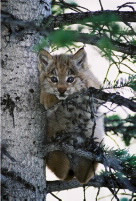contacts
Kristina Johnson, (415) 977-5619, Kristina.Johnson@sierraclub.org
Michael Garrity, (406) 459-5936, garritymichael@yahoo.com
Megan Corrigan, (303) 546-0214, megan@nativeecosystems.org
Endangered lynx will need more room to roam as climate changes, groups contend
 Missoula, Montana – Citing the impacts that global warming will have on the endangered Canada lynx, four conservation groups filed a legal challenge on May 26th in Federal District Court in Missoula against the U.S. Fish and Wildlife Service (FWS) challenging the agency’s selection of designated lynx habitat. The Alliance for the Wild Rockies, the Sierra Club, Native Ecosystems Council and the Center for Native Ecosystems argue that the land area that FWS intends to designate as critical habitat for the lynx is not sufficient to protect the wild cat, making this the first such challenge to rely on concerns over global warming’s impacts to habitat.
Missoula, Montana – Citing the impacts that global warming will have on the endangered Canada lynx, four conservation groups filed a legal challenge on May 26th in Federal District Court in Missoula against the U.S. Fish and Wildlife Service (FWS) challenging the agency’s selection of designated lynx habitat. The Alliance for the Wild Rockies, the Sierra Club, Native Ecosystems Council and the Center for Native Ecosystems argue that the land area that FWS intends to designate as critical habitat for the lynx is not sufficient to protect the wild cat, making this the first such challenge to rely on concerns over global warming’s impacts to habitat.
Michael Garrity, Executive Director of the Alliance for the Wild Rockies said, “While we are glad to see FWS designate lynx habitat, the new designation will not ensure the survival of the species because it leaves out lynx habitat in important travel corridors. More habitat is vital, especially in Montana’s Lolo, Beaverhead-Deerlodge, Gallatin, Bitterroot, Helena, Lewis and Clark National Forests, and in the Clearwater and Caribou-Targhee National Forests in Idaho in order to recover the lynx population.”
“For the lynx to survive in a changing climate, the Fish and Wildlife Service must provide appropriate habitat and create wildlife corridors that will allow for migration as temperatures rise,” said Bruce Hamilton, Sierra Club’s Deputy Executive Director. “The current designation fails to consider the effects of climate change on lynx habitat, and that is unacceptable.”
In February 2009 the FWS revised its designation of critical habitat for the Canada lynx, a medium-sized wild cat about as large as a bobcat. The approximately 39,000 designated square miles in Maine, Minnesota, Montana, Wyoming, Idaho, and Washington represent a tremendous amount of protected habit. But these areas only include some current lynx habitat and exclude areas that will become important to lynx as the climate changes, especially high-altitude snowy areas.
The FWS also afforded no protection to the Southern Rockies of Colorado, despite the presence of a breeding lynx population. Colorado reintroduced lynx in the Southern Rockies in 1997, and more than 100 lynx kittens have been born in the region since the reintroduction effort began. Experts believe that the higher elevation habitat in the Southern Rockies portion of the lynx’s range may be increasingly important for lynx survival as the climate warms.
“Coloradans have done a great thing by bringing back our lost lynx, but if the FWS won’t protect lynx habitat, we could lose them again,” said Megan Mueller, staff biologist with Center for Native Ecosystems. “Loss of this population could threaten the long-term survival of the lynx.”
The conservation groups contend that the agency failed in its selection to consider the evidence of the impacts of climate change on the Canada lynx. FWS also failed to designate all the occupied and unoccupied areas that are essential to the conservation of the lynx as required by the Endangered Species Act (ESA). Finally the agency did not base its critical habitat designation on the best scientific data available, as the ESA requires.
“Instead of properly designating the occupied areas that contain features essential to the conservation of the lynx as required by the ESA, the FWS insists on limiting critical habitat designation to areas that already have large breeding lynx populations,” said Dr. Sara Johnson, a former wildlife biologist for the Gallatin National Forest and the Director of Native Ecosystems Council. “The ESA requires the FWS to try and recover lynx populations so they can eventually be removed from the endangered species list, but this critical habitat designation falls far short.”
The groups are represented in the challenge by Eric Huber with the Sierra Club.
Background
The Canada lynx has long legs and large paws that distinguish it from other cats and help it hunt in deep snow. Due to its highly specialized predator-prey relationship with the snowshoe hare – a species evolved to survive in areas that receive deep snow – the Canada lynx is highly dependent on snow-covered areas. The lynx also starred in the 2008 animated film The Missing Lynx.
For more information, visit:
http://www.wildrockiesalliance.org/
http://www.sierraclub.org/habitat/
http://www.nativeecosystems.org